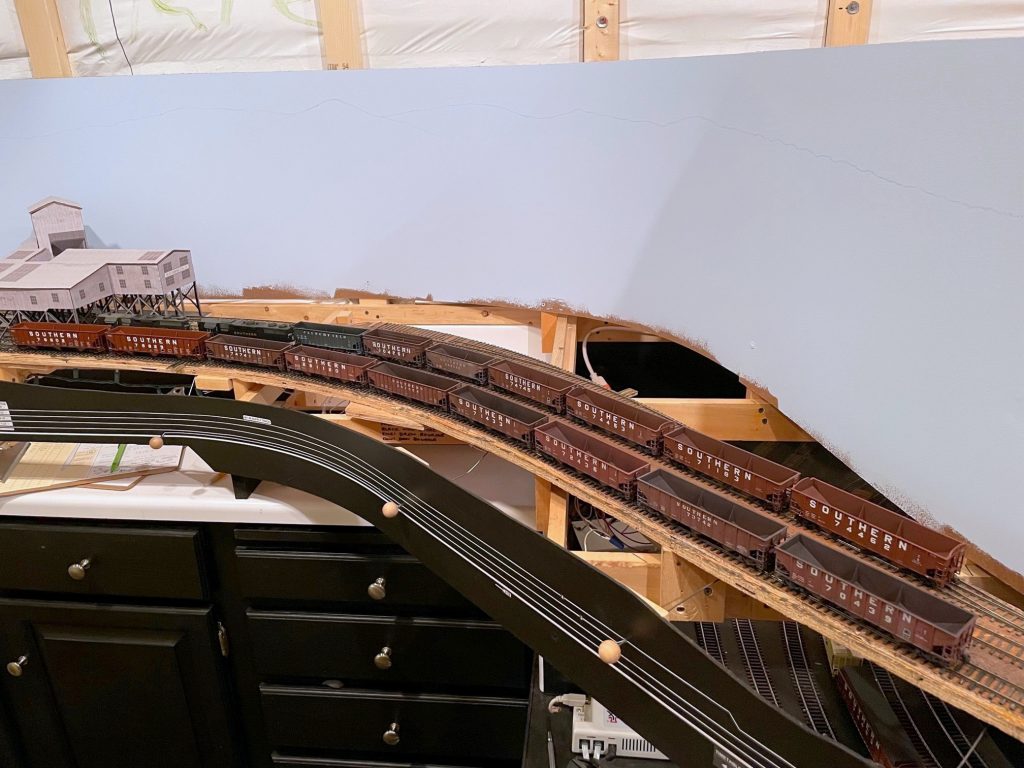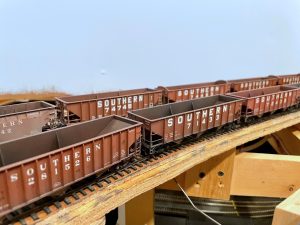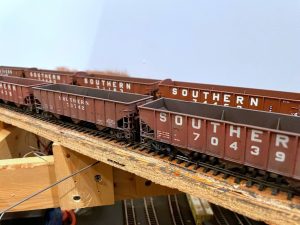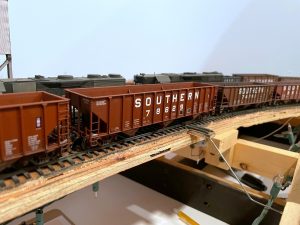
The St Charles Branch would like to welcome the Southern Hopper Class of April 2022 to the roster! The 16 cars in this graduating class are the largest group of cars I’ve ever finished at one time (and probably the largest group I’ll EVER attempt at one time). The 16 hoppers, including a foreign exchange student from the Clinchfield, represent cars across the layout’s range of ops session eras from mid ’60s (cars still in roman font) to the mid ’70s (brand new 100T hoppers). Consequently, all were weathered a bit differently from a 55T twin with dents and lots of grunge to brand new with just a little grime on the trucks and underside.

A few of the cars (CRR 70T and 50T extended-height war-emergency rebuild) have been complete and just awaiting weathering for several years. Some of the cars have been running on the layout for a while but didn’t yet have their full set of details or weathering. The bulk of the cars are Atlas 70T Trainman hoppers, which I love because they’re relatively cheap but have good wheels and trucks and great paint for budget cars. Some Trainman hoppers got a full set of new grabs (did this a while ago). Most Trainman hoppers (along with a pair of Bowser/Stewart 12 panel hoppers) got the standard treatment of getting the grabs shaved down to a more reasonable thickness front-to-back using an X-Acto blade. Other added details include Kadee #5s, plastic bits for tack boards and door bars, wire grabs adjacent to the couplers, homemade tow loops, homemade train lines (copper wire from Cat 5 cable), and homemade coupler cut bars (bent from .012″ brass wire on a homemade jig). A few got dents added in the top sill by softening them with a 100W lightbulb. A few of the cars came with heap shields (correct only for a small number of ex Central of Georgia cars) that got removed as well. I also swapped out the trucks on the Tangent 100T cars–I decided I wanted cars that roll well more than neat spinning roller bearings.

All but one of these cars is factory painted which saves a TON of time. I changed some of the numbers by scraping them off gently with an X-Acto chisel blade (along with the later round “O”s on some of the Atlas cars) and replaced them with decals. Most cars received ACI labels (1967+) and a couple got lube plates (1974+). Before weathering, I covered some of the weight and shop stencils with rectangles of masking tape to represent re-stenciled cars. I ran them through a weathering assembly line that included coats of various thickness of airbrushed flat black followed by light tan. I then painted out a few more weight panels with fresh oxide red and added some stencil data in a different font to a couple cars. A few of the cars got some drybrushed rust marks too. Finally, most of the cars got a wash of flat black inside and out. Overall I’m really happy with how they turned out, but I don’t think I’ll ever assembly line 16 cars again… do you know how many wheel faces that is to paint? 16 cars x 8 wheels x 2 faces per wheel = a ton of wheels (that’s 128 wheels and 256 faces… don’t hurt yourself doing the math)! Still, it will be worth it to see coal trains with a lot fewer shiny cars in the mix.

Hi Dan
Can you share a picture of the jig you made for the coupler cut bars? This is a great article, I’ll follow this on my Trainman cars too.
Ray, I haven’t forgotten about your question. I’m debating doing a write-up on the jig, but even if I don’t, I’ll share a picture soon.